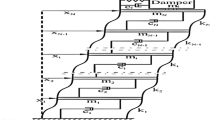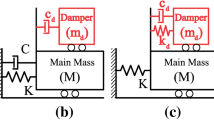Abstract
The seismic events occurred in recent years highlighted the extreme vulnerability of large part of the existing constructed facilities and the need to adopt innovative solutions to improve their seismic performance. With this purpose, the possible exploitation of a seismic early warning system (SEWS) in the framework of semi-active structural control using magnetorheological (MR) dampers is herein investigated. The main idea consists in the use of these time-varying properties devices to control an hosting structure by changing their behaviour according to an anticipate estimate, provided by the SEWS, of the peak ground acceleration (PGA) of the incoming earthquake. In this way, the dampers are able to adapt their mechanical characteristics to the specific earthquake obtaining the optimal seismic response. The present paper describes the application of this protection technique to a case-study problem, a highway bridge located in Southern California. The seismic response of the benchmark bridge is investigated by nonlinear time-history analyses by adopting 16 real earthquake ground excitations. These accelerograms cover a wide variety of magnitudes, distances to fault and soil types. Possible errors on estimation of PGA provided by SEWS and their effects on the proposed control system are also considered. The results obtained confirm that unavoidable errors in the PGA estimates provided by the SEWS do not propagate to the seismic response. Conversely, the proposed strategy turns out to damp these errors, resulting in a robust seismic behaviour of the protected structure.













Similar content being viewed by others
References
Agrawal A, Tan P, Nagarajaiah S, Zhang J (2009) Benchmark structural control problem for a seismically excited highway bridge—Part I: Phase I Problem definition. Struct Control Health Monit 16:509–529. doi:10.1002/stc.301
Brown HM, Allen RM, Hellweg M, Khainovski O, Neuhauser D, Souf A (2011) Development of the ElarmS methodology for earthquake early warning: Realtime application in California and offline testing in Japan. Soil Dyn Earthq Eng 31:188–200. doi:10.1016/j.soildyn.2010.03.008
Caterino N, Spizzuoco M, Occhiuzzi A (2011) Understanding and modelling the physical behaviour of magnetorheological dampers for seismic structural control. Smart Mater Struct 20:065013. doi:10.1088/0964-1726/20/6/065013
Caterino N, Iervolino I, Manfredi G, Cosenza E (2008) Multi-criteria decision making for seismic retrofitting of RC structure. J Earthq Eng 12:1–29. doi:10.1080/13632460701572872
Chu SY, Soong TT, Reinhorn AM (2005) Active. Hybrid, semi-active structural control: a design and implementation handbook. Wiley, ISBN 13 978-0-470-01352-6
Convertito V, Iervolino I, Zollo A, Manfredi G (2008) Prediction of response spectra via real time earthquake measurements. Soil Dyn Earthq Eng 28:492–505. doi:10.1016/j.soildyn.2007.07.006
De Iuliis M, Petti L, Palazzo B (2008) Semi-active control of structures by using earlywarning seismic network information. In: Proceedings 4th European conference of structural, control, pp 367–374. ISBN: 9785904045104
Erdik M, Fahjan Y, Özel O, Alcik H, Mert A, Gul M (2003) Istanbul earthquake rapid response and the early warning system. Bull Earthq Eng 1:157–163. doi:10.1023/A:1024813612271
Espinosa-Aranda J, Jimenez A, Ibarrola G, Alcantar F, Aguilar A, Inostroza M, Maldonado S (1995) Mexico city seismic alert system. Seismol Res Lett 66(6):42–53. doi:10.1785/gssrl.66.6.42
Eurocode 8 (2003) Design of structures for earthquake resistance—Part 1: General rules, seismic actions and rules for buildings. Brussels
Iannaccone G, Zollo A, Elia L, Convertito V, Satriano C, Martino C, Festa G, Lancieri M, Bobbio A, Stabile TA, Vassallo M, Emolo A (2009) A prototype system for earthquake early-warning and alert management in southern Italy. Bull Earthq Eng. doi:10.1007/s10518-009-9131-8
Iervolino I, Galasso C, Manfredi G (2008) Information-dependent lead-time maps for earthquake early warning in the Campania region. In: Proceedings of 14th World conference on earthquake engineering
Iervolino I, Giorgio M, Galasso C, Manfredi G (2009) Uncertainty in early warning predictions of engineering ground motion parameters: what really matters? Geophys Res Lett 36 L00B06, doi:10.1029/2008GL036644
ITACA, Italian Acceleration Archive (http://itaca.mi.ingv.it)
Kanda K, Kobori T, Ikeda Y, Koshida H (1994) The development of a “Pre-arrival transmission system for earthquake information” applied to seismic response controlled structures. In: 1st world conference on structural, control, TA-3, pp 23–32
Maddaloni G, Caterino N, Occhiuzzi A (2011) Semi-active control of the benchmark highway bridge based on seismic early warning systems. Bull Earthq Eng 9(5):1703–1715. doi:10.1007/s10518-011-9259-1
Maddaloni G (2012) Use of a seismic early warning system to calibrate variable dampers for structural control of a highway bridge. In: Proceedings of 5th international conference on structural control-EACS, Genoa, June 18–20, Italy. ISBN 978-88-95023-13-7
Maddaloni G, Magliulo G, Cosenza E (2012) Effect of the seismic input on nonlinear response of r/c building structures. Adv Struct Eng 15(10):1861–1877. doi:10.1260/1369-4332.15.10.1861
Nagarajaiah S, Narasimhan S, Agrawal A, Tan P (2009) Benchmark structural control problem for a seismically excited highway bridge—Part III: phase II sample controller for the fully base-isolated case. Struct Control Health Monit 16:549–563. doi:10.1002/stc.293
Nakamura Y (1989) Earthquake alarm system for Japan Railways. Jpn Railw Eng 8(4):3–7
NTC (2008) DM 14 Gennaio 2008. Norme tecniche per le costruzioni. Gazzetta Ufficiale della Repubblica Italiana, 29 (in Italian)
Occhiuzzi A, Spizzuoco M, Serino G (2003) Experimental analysis of magnetorheological dampers for structural control. Smart Mater Struct 12(5):703–711
Occhiuzzi A, Grasso VF, Manfredi G (2004) Early warning systems from a structural control perspective. In: Third European conference on structural control
Occhiuzzi A, Iervolino I, Manfredi G (2006) Feedforward control algorithms for seismic early warning systems. In: Fourth World conference on structural control and monitoring. 4WCSCM-266
Occhiuzzi A, Caterino N, Maddaloni G (2008a) Exploitation of seismic early warning networks for structural control. In: 4th European conference on structural control
Occhiuzzi A, Caterino N, Maddaloni G (2008b) Structural control strategies for seismic early warning systems. In: 14th World conference on earthquake engineering
PEER, Pacific Earthquake Engineering Research Center (http://peer.berkeley.edu/smcat/)
Pnevmatikos NG, Kallivokas LF, Gantes CJ (2004) Feed-forward control of active variable stiffness systems for mitigating seismic hazard in structures. Eng Struct 26:471–483. doi:10.1016/j.engstruct.2003.11.003
Tan P, Agrawal A (2009) Benchmark structural control problem for a seismically excited highway bridge—Part II: phase I sample control designs. Struct Control Health Monit 16:530–548. doi:10.1002/stc.300
Wang J, Wu Y, Lin T, Brant L (2012) The uncertainties of a Pd3-PGV onsite earthquake early warning system. Soil Dyn Earthq Eng 36:32–37. doi:10.1016/j.soildyn.2011.12.005
Wenzel F, Marmureanu G (2006) Earthquake information systems. In: Pageoph Topical Issue, Proceedings of international Tsumani symposium, vol 22. Chania, Greece
Wu YM, Teng TL (2002) A virtual subnetwork approach to earthquake early warning. Bull Seismol Soc Am 92(5):2008–2018
Zollo A, Iannaccone G, Lancieri M, Cantore L, Convertito V, Emolo A, Festa G, Gallovic F, Vassallo M, Martino C, Satriano C, Gasparini P (2009) Earthquake early warning system in southern Italy: methodologies and performance evaluation. Geophys Res Lett. doi:10.1029/2008GL036689
Acknowledgments
This research has been partially funded by the Italian Department of Civil Protection in the frame of the national project ReLUIS 2009–2012: Theme 3.
Author information
Authors and Affiliations
Corresponding author
Rights and permissions
About this article
Cite this article
Maddaloni, G., Caterino, N., Nestovito, G. et al. Use of seismic early warning information to calibrate variable dampers for structural control of a highway bridge: evaluation of the system robustness. Bull Earthquake Eng 11, 2407–2428 (2013). https://doi.org/10.1007/s10518-013-9510-z
Received:
Accepted:
Published:
Issue Date:
DOI: https://doi.org/10.1007/s10518-013-9510-z




